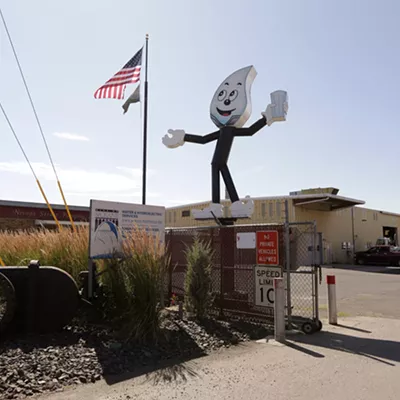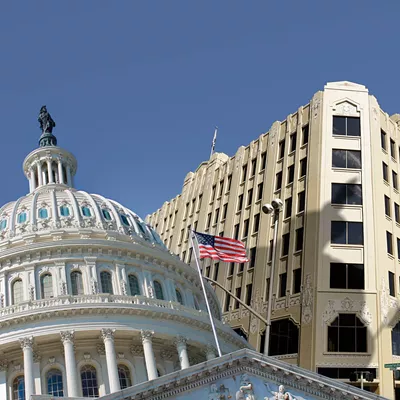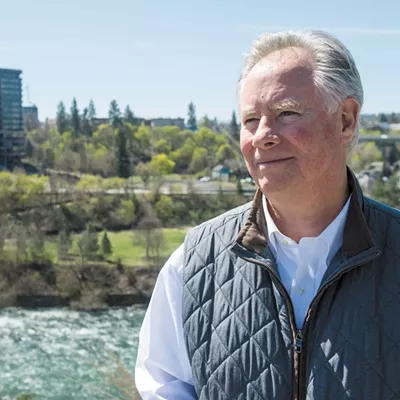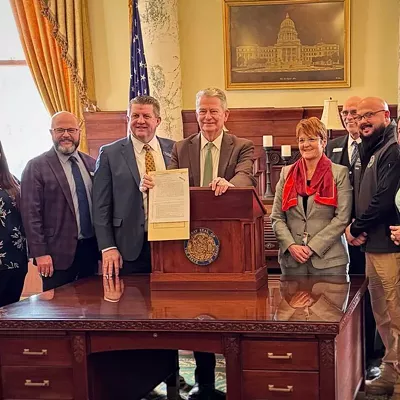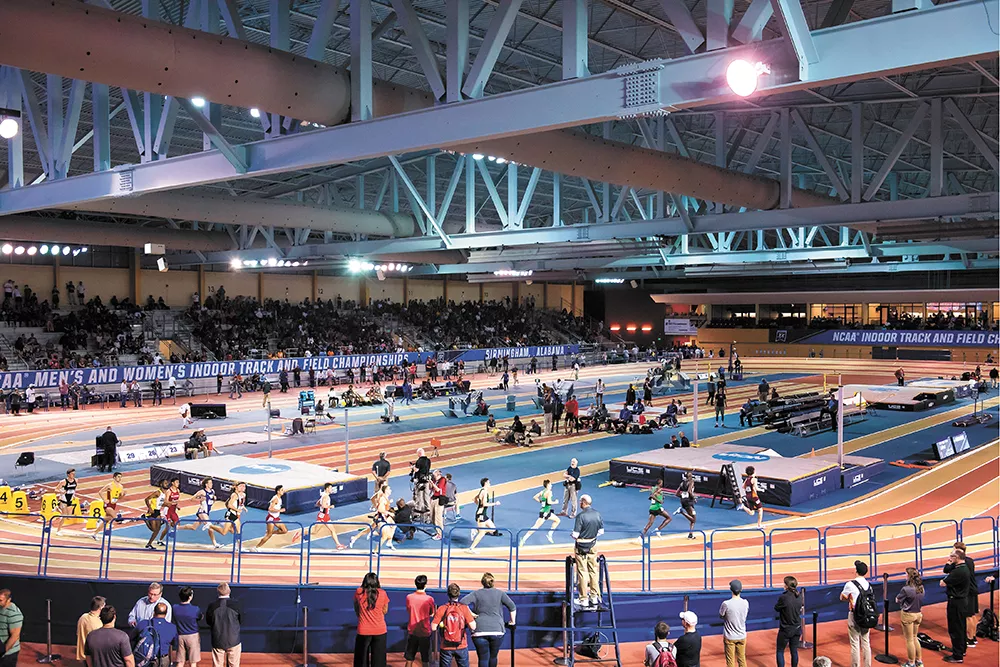
At its core, every great sports story is about tenacity. She keeps running even though her legs have turned to jelly. The team's down three touchdowns, but never stops driving forward. He gets knocked down, but he gets up again.
Stephanie Curran, director of the Spokane Public Facilities District (PFD), knows this well. Curran quotes from that famous Teddy Roosevelt "man in the arena" speech, the one about how the glory belongs to one "whose face is marred by dust and sweat and blood; who strives valiantly; who errs, who comes short again and again," instead of the one who never risks and never fails.
Last year, Curran was handed the baton from retiring PFD Director Kevin Twohig, and with it the responsibility for the success of the Spokane Arena, the convention center, the First Interstate Center for the Arts and the next project that could define the future of the facilities district for decades — the Sportsplex.
Stretching over 130,000 square feet on the north bank of the Spokane River, just east of the Arena, the planned Spokane Sportsplex would feature an indoor 200-meter, six-lane hydraulically banked track, which can be reconfigured to hold 17 volleyball courts, 10 basketball courts or 21 wrestling mats. Initially, that was all to be accompanied by an NHL-sized ice rink.
At a PFD board meeting in July, one of the attendees congratulates the Sportsplex team on the fact they've had a lot of "hoops and hurdles to deal with."
"Hurdles?" Curran interjects, with a half-laugh. "Really?"
It's an understatement. Construction hasn't even begun, but in the past four years, the Sportsplex dream has been dogged by challenging land deals, financing packages, false starts, setbacks, delays, price spikes and skepticism from the public.
Meanwhile, dozens of other communities are racing to build their own facilities, spurred by similar visions for how sports tourism could generate a massive economic impact. Yet in some communities, big sports complexes have also come with big downsides, as their "sports meccas" have hemorrhaged money and run up million-dollar budget deficits.
A few months ago, the Inlander received one of those no-return-address letters. This one, however, had a bundle of highlighted PFD meeting minutes and a typed-out anonymous note.
"Is anyone paying attention to the Sportsplex? The public was told that it would cost $42 million and would include an ice arena. The cost is now up to $52 million and the current building plans do not include an ice arena," it reads. "Does the public know this? The answer is 'No.'"
The letter is out of date: Today the cost is up to $53 million.
But Curran, like the many others who've been fighting for the Sportsplex, says the finish line is almost in view. And she swears that the reason they've been so persistent is because the destination is worth it.
"We have had many excellent excuses to walk away from this in the last six months," Curran says. "Trust me, I've driven home many nights, thinking, 'There's no way this is going to work.' And then you get your head on and you say, 'You know what. This is a 50-year mistake if we don't do this.'"
THE RACE
It was the final indoor race of her college career. Whitworth University track athlete Kayla Leland had flown all the way to Alabama for the 2018 Indoor National Championships at the Birmingham CrossPlex.
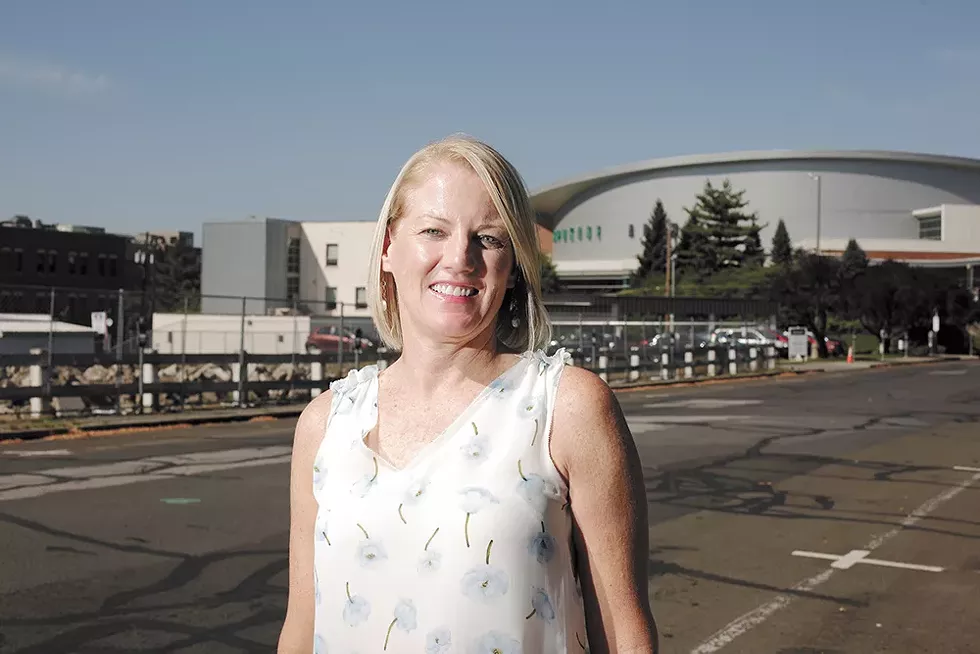
And then, just before the national anthem, she saw something she'd never witnessed before. The track itself started to move. The ends began to slide up.
Birmingham has a hydraulically banked indoor track. So each time Leland hit the curve, the angle of the track allowed her to counter the centripetal force of the turn and maintain her speed. "Running on it felt like it propelled you forward," Leland says. "It was one of the best tracks in the world."
And unlike the banked track in, say, Boise, hydraulically banked tracks can be dropped down with a switch of a button to make it easier for sprinters running the 50-meter dash. There are only a handful of such tracks in the world, and as a result, Birmingham has become a serious contender to land any national indoor track event.
Around 120,000 athletes and spectators attend track events at the facility every year, the CrossPlex's Preston Kirk estimates — including 90,000 from outside the county. And that's not even including the athletes who come to basketball games, wrestling matches, cheerleader competitions or for the Olympic-sized pool.
It results in tens of thousands of Birmingham's hotel rooms being booked, restaurants being patronized and shopping malls being frequented, particularly in the traditionally slow winter months. According to local Birmingham news reporting, it breathed life back into an economically depressed part of the city.
"We've had about 16 cities call us about what we've done," Kirk says. "We've gotten to know Spokane."
Spokane Sports Commission CEO Eric Sawyer flew to visit in April. Sawyer is a salesman at heart, and the product he sells is Spokane. In the past three years he's helped convince organizers for national championships of track, cross-country, roller sports, judo, weightlifting and curling to come to Spokane. Just imagine, he says, what Spokane could get with something like the CrossPlex. He says he's been thinking about that for 25 years.
So lately, he's applied his salesmanship to selling the Sportsplex to Spokane.
"If you can bring in visitors who bring in dollars, making purchases and driving sales taxes, that's money that we don't have to pay," Sawyer says. "Any state that's sales-tax reliant, if they aren't in the tourism business, they're crazy."
And sports tourism is big business. Even during the Great Recession, as every other tourism sector was flailing, Sawyer says sports tourism was growing. Disneyland may be optional, but there's no way in hell Dad's telling his little volleyball star she can't go to nationals.
That's why Birmingham's CrossPlex touts a $100 million annual economic impact. That's why the Spokane sporting event with the biggest economic impact — the one that brings in the most hotel guests and tourism dollars to the city — isn't Bloomsday or Hoopfest, Sawyer says. It's the Pacific Northwest Qualifier, a two-weekend youth volleyball tournament held each year in March.
Sports economists argue that venues like stadiums don't spur economic activity so much as shift it — with locals paying for game tickets instead of going out to eat at a local restaurant. But Sawyer argues that the Sportsplex model is different: Instead of Spokanites, the Sportsplex seats will be filled with out-of-towners shelling out out-of-town cash. A 2015 Gonzaga University study estimated that the Sportsplex could generate $19 million to $33 million in economic impact every year — and at least $1 million in extra tax revenue.
"It's kind of an arms race right now around the country."
But other academics, like West Virginia University sports economist Brad Humphreys, remain wary. The big sports tourism complex is a relatively new invention. And of the few comparable sports complexes, the Gonzaga study acknowledges, "information regarding the impact of these facilities is difficult to obtain either because the facility is too new, or because it is privately held and they are not forthcoming with data."
"There's really very little evidence if they will differ substantially from stand-alone stadiums and arenas," Humphreys says. "There's a lot of people who are optimistic. They are almost always consultants."
Other cities have their own boosters who are also making their own sales pitches for new facilities. Officials in Bloomington, Illinois; Madison, Wisconsin; Windsor Locks, Connecticut; Williamsburg, Virginia; and Hutto, Texas, have all rolled out proposals for their own massive sports complexes, waving reports from Sports Facilities Advisory, the same consulting firm that praised the Sportsplex proposal in Spokane in 2015.
The study by the Sports Facilities Advisory noted that the Spokane Sportsplex had a huge advantage because its hydraulic indoor track would be the only one on the West Coast. But if another comparable track facility were built, the study warned, it "would meaningfully impact the performance" of the Sportsplex.
"It's kind of an arms race right now around the country," Sawyer says. "We're in the front of a wave."
Yet today, there's already another Pacific Northwest facility in the development queue. When Eugene, Oregon, hosts the World Athletics Championships in 2021, the neighboring city of Springfield plans to showcase the site and design of its new sports complex, featuring a hydraulically banked track.
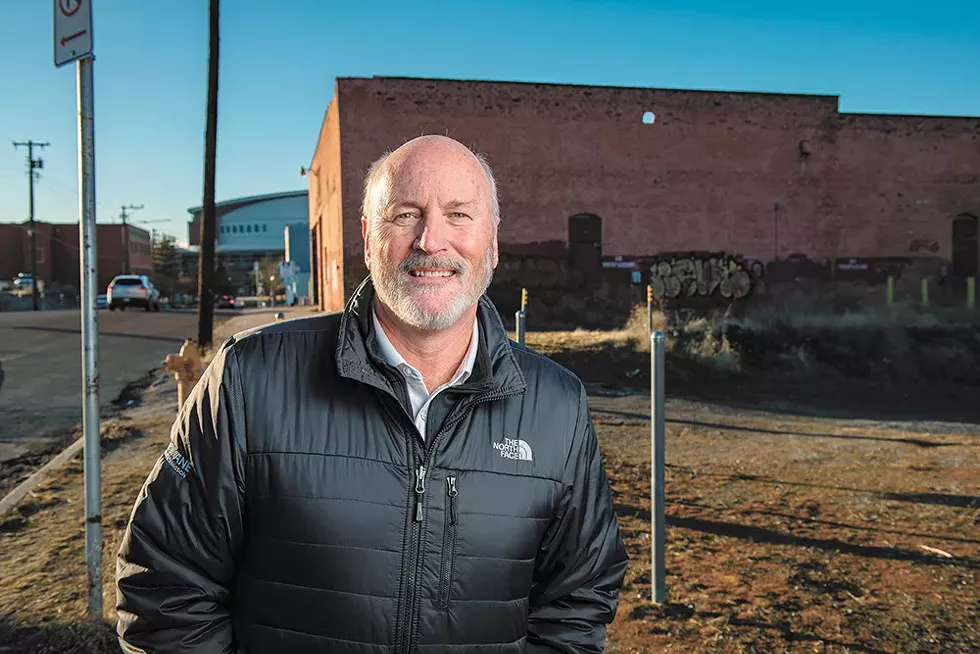
But Sawyer, ever the optimist, doesn't miss a beat. Think of the potential synergy, he says. They could partner up and make an indoor Pacific Northwest running season possible.
"We kinda want them to do it," Sawyer says. "They will help us sell our market."
Besides, Springfield doesn't have the money yet.
"They're trying to figure out how to finance it without taking it the voters," Sawyer says.
And he knows just how crazy difficult cobbling together all that financing can be.
THE SITE
More than a few proposals to build on the north bank of Riverfront Park have crashed and burned. A science center. An aquatic center. A relocated IMAX. Instead, the land, purchased by the Parks Department in 1999, remained nothing more than a dirt pile.
But former Parks Director Leroy Eadie, Sawyer says, had a proposal: Lease the land to the PFD for nearly nothing. Let them use it to build the Sportsplex.
The Park Board, Sawyer says, was initially divided. But Sportsplex advocates sold them by promising to let the department use the facility rent free and by portraying the Sportsplex as simply an extension of the park's recreational mission.
"This gave us a gateway into the park," Sawyer says. "It also [will bring] 43,000 visitors into the park with cash in their pockets."
Let other cities put their sports complexes out in the boonies. Spokane would put it right next to downtown. Athletes would walk through the new Riverfront Park promenade to a bevy of hotels and downtown restaurants.
"It's a hop, skip and a jump," says Toni Hansen, executive director for the Spokane Hotel-Motel Association. "It's just going to be amazing."
The park land was one piece of the puzzle. Cobbling together the rest was an exhausting journey.
"I've been telling people lately, 'It's like a Jenga game,'" Curran says. You gingerly handle a problematic piece, risking the entire structure collapsing with one shaky move. And just when you think you're safe, it's your turn again.
At one moment, the PFD was navigating a long-running lawsuit from the Dance Street Ballroom, a former neighbor of the city-owned Carnation Building on the Sportsplex site. The owner had suffered a nightmare of maintenance problems, including an infestation of raccoons.
At another, PFD officials were negotiating with the Spokane Federal Credit Union over property at the southwest corner of the site. If the negotiations failed, they would have had to move the building, sticking the Sportsplex close enough to a Homeland Security building to trigger new fire code requirements — a 15-foot move with a $1.5 million price tag.
Even land itself — the dirt, soaked in railroad waste — gave them problems, costing the PFD $800,000 to clean it up.
The irony? They could have saved themselves all that trouble.
"We could have moved the Sportsplex north onto our parking lot and had none of these problems," Curran says. "We wouldn't have had to purchase any land, we could have made this as big as we wanted, we wouldn't have had any of this environmental stuff."
It might have saved some time and money. But the district would have lost parking spaces, Sawyer says, and more importantly, the district would have lost the site it has now: A Sportsplex, connected to Riverfront Park, perched on a bluff, looking out across the roaring Spokane River.
"I can't wait to sell that," Sawyer says.
THE VOTE
Of course, Sawyer and Curran don't have to convince you of the merits of the Sportsplex. Not any more. Originally, voters were going to have a say. For two years, the PFD board discussed sending a proposal to the ballot.
In 2017, Spokane County had initially planned a property tax hike that would have partially funded both the Sportsplex and a slew of county parks.
But the timing couldn't have been worse. County Commissioner Al French says the county was facing a $10 million deficit. Residents were already seeing their property taxes spike because of a state requirement to invest more in public schools.
That year, the three Republican county commissioners weren't even willing to raise taxes to fund public safety measures — much less for a new athletic facility.
And yet, in 2018, voters did get a chance to vote on a proposed athletic facility next to the Arena. It just wasn't the Sportsplex.
District officials at Spokane Public Schools were preparing to tear down the crumbling Joe Albi Stadium and wanted to use the parking lot north of the Sportsplex site for the replacement. And the district decided to ask voters what they thought. The voters, it turned out, were worried about parking and traffic — and what was wrong with keeping the old stadium? — and the advisory vote went down in flames.
The idea of marrying the stadium and the Sportsplex came too late.
"We were looking at two boxes and we go, 'You know those boxes are pretty close to the same size. I wonder if you could put a football field inside of the Sportsplex, and how do you do that?'" Sawyer recalls. "We were like, 'Oh my God, this could be cool.'"
It could have saved millions. But by the time they'd had that "aha moment," Sawyer says, the advisory vote proposal was already on the ballot. They didn't want to confuse voters.
And after the measure failed, the school board didn't want to appear as though they were defying voters. Curran says she thinks that missing that opportunity to combine the facilities was a "50-year mistake." She still hears from voters who react to the efforts to build Sportsplex by insisting, incorrectly, that the community had voted it down.
Ultimately, the PFD found a way to fund the project without having to get voters' permission.
THE DEALS
When Curran was officially hired as the PFD director, in October 2017, "the Sportsplex was dead," she says. Or, at least, it was on life support.
"Everybody was getting cold feet," Sawyer says. "We had a project with no funding."
Behind the scenes, Sawyer says, Twohig, the outgoing director, cobbled together a strategy and Curran brought it home. They needed to find at least $42 million.
Ultimately, paying for the Sportsplex involved axing part of the design, spending half their reserves, taking out a major loan and seeking aid from the state, the city and the county.
"This is an epic story of intergovernmental cooperation," says PFD Board Chair Larry Soehren.
The city of Spokane chipped in $5 million. City Councilwoman Kate Burke had condemned the project as a "taxpayer-funded $5 million giveaway to an unelected, unaccountable body in the name of bad economics," but the rest of the City Council supported it.
"I think that if you go 10 years in the future, you're not even going to recognize the north bank of the river," Council President Ben Stuckart says. "I think it's extraordinary."
Next, the PFD looked to the state Legislature, hoping to get $2 million or more. In the end, it got $1 million. Not ideal, but enough to keep going.
The PFD also had another big source of funding saved up, if only the team could get to it.
When the PFD took on debt by issuing bonds to expand the convention center and refurbish the performing arts center, it was required to keep millions of dollars locked away in their reserve accounts. Opening that lockbox meant paying $580,000 to insure those bonds. On one hand, it freed up $11 million for the Sportsplex. On the other, it was a one-time move the PFD won't be able to use again.
For the rest, the PFD took out a loan. Without the county putting a levy on the ballot, they had no choice.
"We went from getting $25 million to having to borrow it," says Brittany Garwood, the PFD's director of finance. "That's huge. Talk about the obstacles. In my mind, that's the biggest one."
But the county still had a role to play: the middleman.
"It's like if you're a parent and you're going to co-sign on a loan for your kid," says County Commissioner Mary Kuney. Just like parents have a better credit rating than their kids, by going through the county to issue bonds, the PFD would get a much better deal on its loan.
The county wouldn't have to pay a dime — but they'd be on the hook if for some reason the PFD started defaulting. And instead of raising taxes, the district would pay back the bonds using a state sales tax rebate — a carveout specifically for public facilities district buildings — that the Legislature extended in 2017.
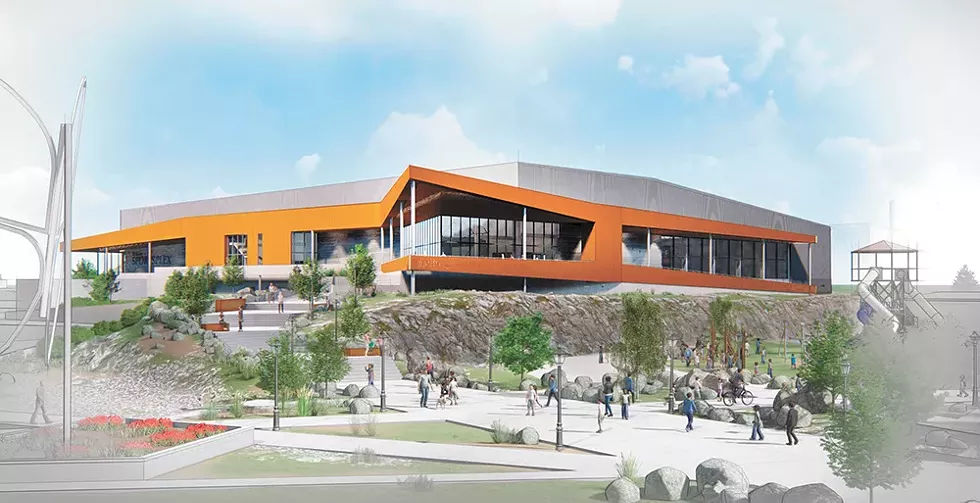
Meanwhile, the cost of the project had grown. The thriving economy, Sawyer says, had driven up construction costs, and $42 million wasn't remotely enough to build the Sportsplex.
So they axed what was intended to be the Sportsplex's biggest revenue generators: the NHL-sized ice rink.
The Downtown Spokane Partnership had been a strong proponent of the rink, noting that it could give the Chiefs hockey team an extra practice space and bolster Spokane's already-legendary reputation for hosting world-class ice-skating events. But one rink wasn't enough to bring in most tournaments, Sawyer says, and they couldn't justify the construction cost.
"The last I'd heard, [the rink] was included," Downtown Spokane Partnership Director Mark Richard says. "That is disappointing."
The PFD has been slow to update the public on its setbacks: Until late last month, the Spokane Sportsplex website had continued to advertise the ice rink as a major part of the project, and the website still claims that the project will cost $42 million.
In fact, even after scaling back the design, the Sportsplex price tag had grown to $53 million.
"They come back to the county and go, 'Well, guess what, we need more money,'" County Commissioner Al French recalls. Instead of taking out a $25 million loan, the PFD was asking for a $35 million loan.
This time, the county was more cautious. "We even took the step of hiring an outside third party that has no interest in the success and failure of the Sportsplex," French says.
With the independent expert's advice, Spokane County supported the facilities district taking out more debt, but with a catch: The PFD will have to either set aside more reserves or pay a little bit more to insure their bond. And until the district makes progress in paying down its debt or building up its reserves, it won't be able to take out more debt without the county's permission.
"It's another level of accountability and oversight over the PFD to make sure they don't get out over their skis," French says.
While the PFD still has at least $10 million saved up, its ability to pay for additional big projects is limited for now. But to Curran, there isn't anything better that the district is missing out on by paying for the Sportsplex.
"We would have to spend it on something else that wouldn't generate the economic impact, like a food court," Curran says. "It's not really in our mission to hold a bunch of money in our account. We're taking that money and putting it back into the community."
THE RISK
For now, the PFD still plans to open the Sportsplex in the spring of 2021.
But even once the Sportsplex ribbon is cut, the hurdles won't stop coming. The PFD still has to run the thing. Finding events to fill the Sportsplex won't be a problem. Sawyer already has a list of over 200 potential events, and he says some organizers are already trying to reserve space.
But it's one thing to bring cool events to Spokane. It's another to do so without sending the Sportsplex deep into the red.
None of the glossy brochures or press releases raving about the Birmingham CrossPlex mention that the facility hemorrhages money. But Birmingham city budget documents show that, in 2013, the CrossPlex lost around $2.2 million. And that gap keeps widening. This year's budget anticipates about $3.6 million in losses. That's partly a consequence of making economic impact such a large priority.
"As the events grow, your costs might grow," says the CrossPlex's Kirk. "We want to have as many events as we can."
Sawyer calls the CrossPlex the "most cost-inefficient operation on the planet," noting that much of its deficit is driven by its Olympic-sized pool.
The PFD's projections for the Sportsplex are much rosier.
In fact, while the Sports Facilities Advisory study had lowballed its estimate for construction costs, Sawyer argues the study was actually too pessimistic when it came to operating costs. Yes, the PFD has agreed to let the Parks Department use the facility rent free, and yes, the PFD ditched the revenue-generating ice facility. But by splitting management costs with the PFD's other facilities and having the sports commission handle marketing, Sawyer argues Spokane can do it better and do it cheaper.
The PFD calculates that the Sportsplex may start out losing over $500,000 in its first year. But it also assumes that in the next four years, it will lose only $50,000 to $75,000, a shortfall easily covered by hotel-motel tax revenue pledged from the Hotel-Motel Association. And after that, the belief goes, it will break even or even turn a profit.
"If you look at other facilities like this around the country, they're all going to be operating at a loss."
Kirk, with Birmingham's CrossPlex, says it's feasible that Spokane could make it work. But he also says that most of these facilities lose money.
"If you look at other facilities like this around the country, they're all going to be operating at a loss," Kirk says. And that's the case with most of the facilities the Sportsplex has been compared to.
The Ocean Breeze Track and Field Athletic Complex in New York City is budgeted to lose about $2.4 million this year. The Reggie Lewis Track and Athletic Center survives by getting $900,000 — nearly two-thirds of its budget — from the state of Massachusetts. In 2011, the Fieldhouse USA facility in Frisco, Texas, fell so far behind in rent payments it had to renegotiate its lease. Even then it took four more years for the facility to climb out of the red.
It's a common enough plight that Sports Facilities Advisory makes that risk a central part of the sales pitch for its sports facility management arm.
"If you're worried that your sports facility is on the path to destruction, Sports Facilities Advisory can help!" reads a 2016 SFA post. At least one sports complex run by the company, stationed in the South Carolina tourist town of Myrtle Beach, was consistently making a profit.
Still, you don't have to look outside of Washington state for a cautionary tale. The Town Toyota Center, opened by the Greater Wenatchee Regional Events Center Public Facilities District in 2008, was such a money loser that it nearly drove the city of Wenatchee into bankruptcy. Voters had to bail the city out with the tax increase.
It's a story that the PFD in Spokane knows well.
"When you have the same company that was going to operate the place making all the guarantees, now you're really on thin ice," former PFD Director Twohig says.
It was a case of the fox minding the henhouse, Twohig says. Wenatchee officials heard what they wanted to hear, Twohig says, and they suffered because of it.
"Wenatchee tainted PFDs across the state," Sawyer says. "Everyone is paying the price."
But this project is different. Consulting firms from the state, county and PFD have all examined pieces of the Sportsplex puzzle and given the project the green light. Studies stress-tested the project, showing that even in worst-case scenarios, like an economic slump deeper than the Great Recession, the PFD wouldn't collapse and county taxpayers wouldn't be seriously at risk.
"Even if it was losing a million dollars a year — which I think we can do better than — that is not going to hobble the district," says Soehren, the board chair. "That would be inconvenient, but we still have other tax revenues coming in."
After all, the more people the Sportsplex puts into local hotels, the more revenue the PFD gets from the hotel-motel tax. Even if it loses money, the Sportsplex could pay for itself indirectly — and boost local businesses in the process.
"I just think this is going to be a home run," Soehren says. "This will be the case where we will all look back and say, 'You know, that might have been a little bit like childbirth, but now the kids are doing great,' and you forget the pain."
Remember, the PFD expanded the convention center, despite experts warning the conventions market was oversaturated. But the expansion worked: It cleared the way for the Davenport Grand Hotel, increased convention attendance, and the last few years the convention center has actually turned a small profit.
"District projects have all gone really well, despite some of the misgivings," Twohig says. "People thought the sky was going to fall with the Arena, and it didn't."
Today, though, Spokane Arena General Manager Matt Gibson says there are still a lot of questions that need to be asked. Most arenas are replaced after 30 or 40 years — and the Spokane Arena turns 25 next year. How would the Arena be affected by the Sportsplex? How would future projects be financed?
Gibson only had permission to speak about the Arena, not the Sportsplex, but he also says that choices being made now may "affect things 15 years down-line."
"There's a whole lot of unknowns out there," Gibson says.
Internally, there has been concern. While Bobby Brett, owner of the Spokane Chiefs hockey team, tells the Inlander he doesn't want to "speak out of turn," PFD board meeting minutes from May show Brett worried that dipping too much into the district's reserves could have a negative impact on other facilities.
A 2018 Department of Commerce-commissioned study also raised the idea that the lack of remaining debt capacity could potentially put the PFD in "a vulnerable position if a major facility emergency were to arise — as with the need to make unforeseen significant repairs or building renovations."
Any risks to building the Sportsplex, Curran and Sawyer both argue, are minimal.
"We will make it work. We will. There is no question in my mind. There is zero doubt," Curran says. "That's what leadership is: You take something that people think can't be done and you make it happen."
Spokane, Sawyer notes, has a reputation of being afraid to take risks. But he believes that's beginning to change. He says it has to.
"At the end of the day, we have to compete as a community," Sawyer says. "If aren't willing to take the risk and compete, I'd say get out of all this stuff, and we can be a little provincial suburb with a cow town." ♦
Daniel Walters has been writing for the Inlander since 2008. In that time, he's written about Spokane scandals, con artists, the Ridpath development mess and the local housing crisis. His father and grandfather were track coaches and his personal record for the 1,600-meter is 4:56. He can be reached at 325-0634 ext. 263 or via email at danielw@inlander.com.





